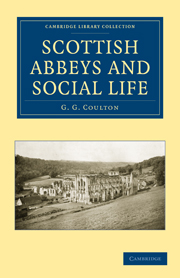Book contents
- Frontmatter
- Contents
- LIST OF ILLUSTRATIONS
- Preface
- Chapter I Celtic Monachism
- Chapter II The Monastic Rules
- Chapter III Monastic Revenues
- Chapter IV How Endowments Came (I)
- Chapter V How Endowments Came (II)
- Chapter VI Monks and Parishes (I)
- Chapter VII Monks and Parishes (II)
- Chapter VIII Charity (I)
- Chapter IX Charity (II)
- Chapter X Monk and Peasant (I)
- Chapter XI Monk and Peasant (II)
- Chapter XII Monastic Housekeeping
- Chapter XIII Church and Scriptorium
- Chapter XIV The Monastic Chronicler
- Chapter XV Schools
- Chapter XVI Art and Learning
- Chapter XVII Professions and Business
- Chapter XVIII Visitation (I)
- Chapter XIX Visitation (II)
- Chapter XX A Voice from the Cloister
- Chapter XXI Conclusion
- Appendixes
- List of Authorities
- Index
- Frontmatter
- Contents
- LIST OF ILLUSTRATIONS
- Preface
- Chapter I Celtic Monachism
- Chapter II The Monastic Rules
- Chapter III Monastic Revenues
- Chapter IV How Endowments Came (I)
- Chapter V How Endowments Came (II)
- Chapter VI Monks and Parishes (I)
- Chapter VII Monks and Parishes (II)
- Chapter VIII Charity (I)
- Chapter IX Charity (II)
- Chapter X Monk and Peasant (I)
- Chapter XI Monk and Peasant (II)
- Chapter XII Monastic Housekeeping
- Chapter XIII Church and Scriptorium
- Chapter XIV The Monastic Chronicler
- Chapter XV Schools
- Chapter XVI Art and Learning
- Chapter XVII Professions and Business
- Chapter XVIII Visitation (I)
- Chapter XIX Visitation (II)
- Chapter XX A Voice from the Cloister
- Chapter XXI Conclusion
- Appendixes
- List of Authorities
- Index
Summary
1
Clerical Warriors
From a contemporary poem on the battle of Durham (Neville's Cross). Printed in Illustrations of Scottish History (Maitland Club, 1834), PP- 63 ff.
Then, as it is reported, David said to his nobles: “There are no men of war left in England; there are none but clerics and water-bearers, therefore these confessors shall become martyrs”… Then the Archbishop [of York], Zouch by name, came with great strictness to confer Holy Orders [upon the Scots]; all those whom he ordained felt his strokes: “Be thou henceforward blessed, brother, to all eternity!” For there was a deacon, Mowbray, an urbane man, and subdeacon Okyll, that white-haired man, who was so profane in conferring such Orders that, after this, he cannot be made a chaplain. For those clerics, called confessors, whom [King] David had called [in contempt] “waterbearers”, gave absolution with cudgels to those who had derided them; and thus they lie in death like sinners. And Mury of Moray, that inordinate man, who is called Earl in contradiction to Church law, because he wedded a wife without licence, now was he degraded to those Orders.
2
The Saint in Disgrace
Lord Hailes quotes a more recent example (Ed. 1797,11, 303).
At this day, the Portuguese sailors address their favourite St Antonio in a like form.
There is a curious passage concerning the Portuguese at Goa, in the travels of a zealous Roman Catholic, de la Boulaye le Gouz, c. 25, p. 204. …
That is, “The Portuguese are extremely fond of St Anthony of Lisbon; they pray to him, in particular, whenever a drought happens. They take his image, fix a rope to its feet, and sink it headlong into a well.
- Type
- Chapter
- Information
- Scottish Abbeys and Social Life , pp. 261 - 267Publisher: Cambridge University PressPrint publication year: 2010First published in: 1933

